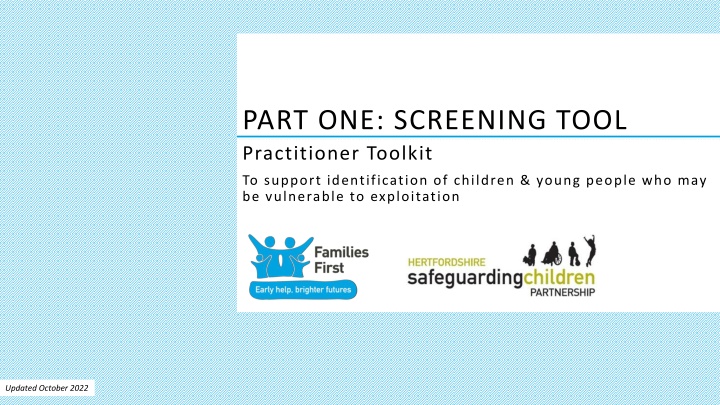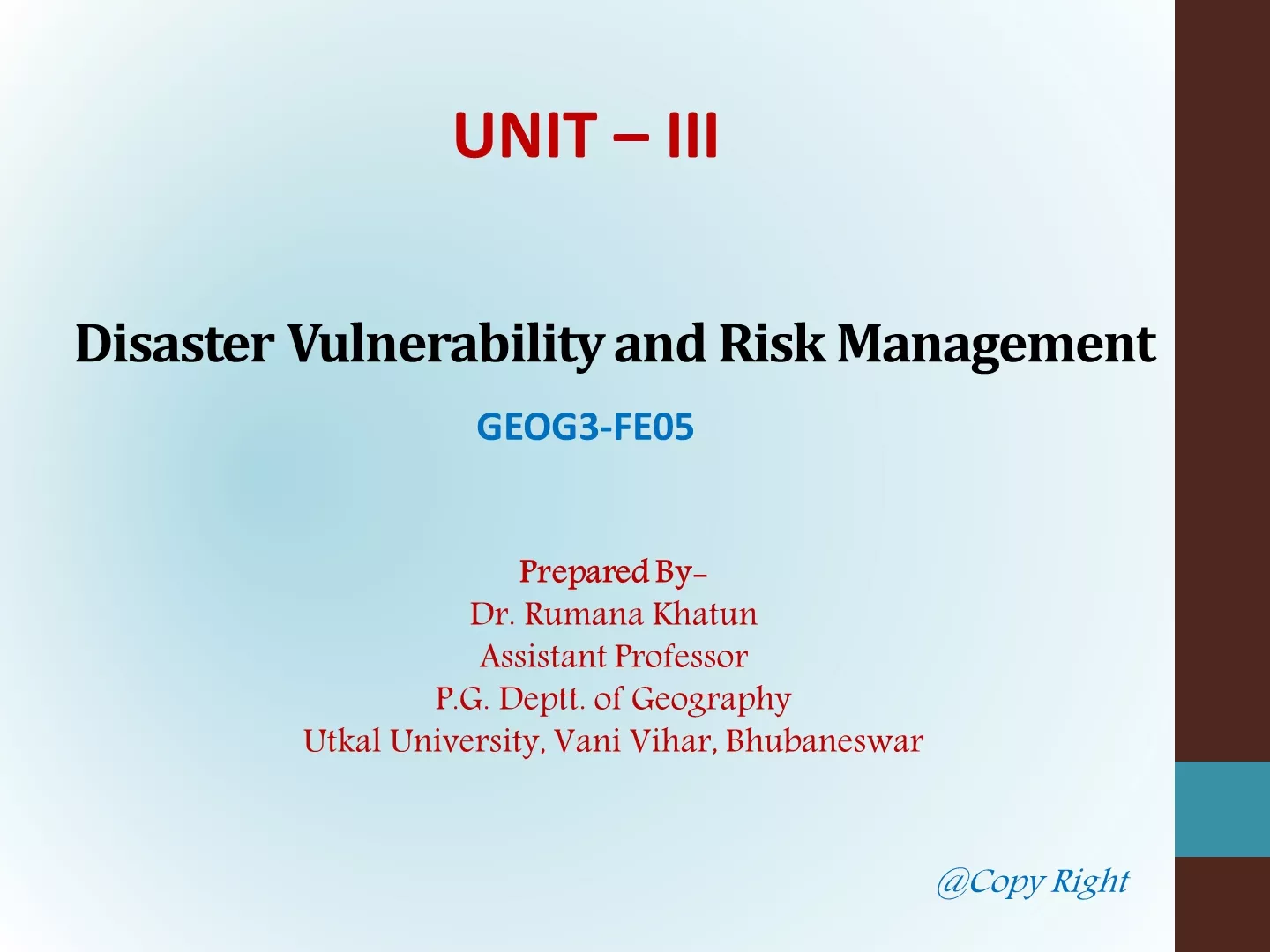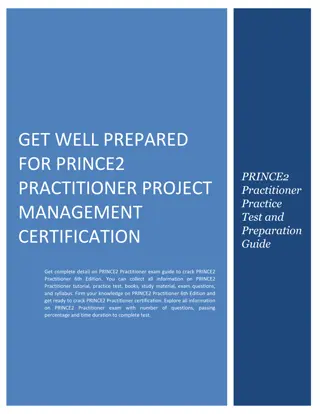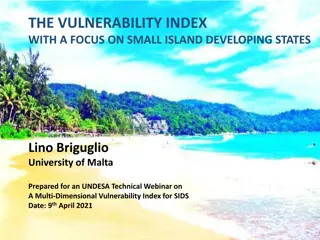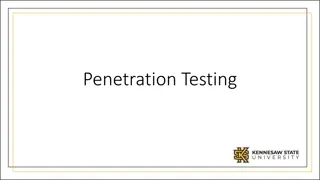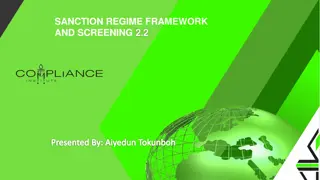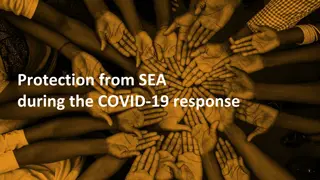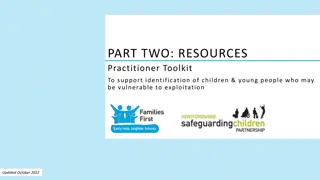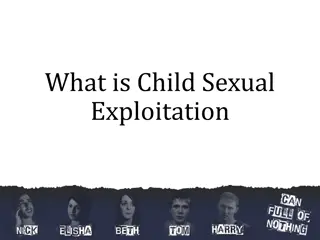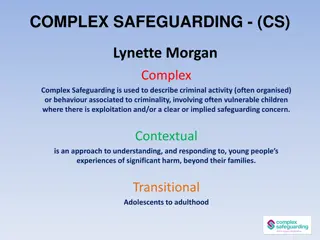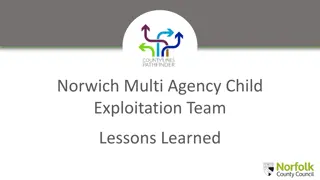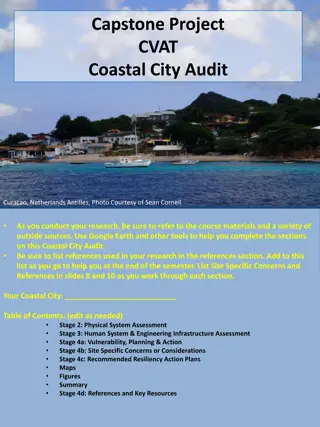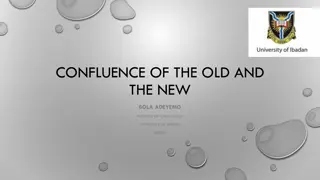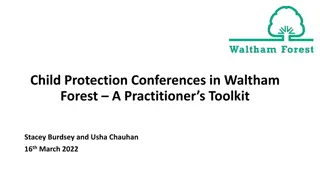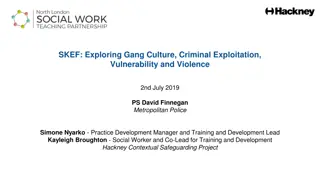Part One: Screening Tool Practitioner Toolkit for Child Exploitation Vulnerability
This toolkit provides practitioners with a screening template to identify children and young people vulnerable to exploitation. It covers indicators, checklists, and guidance for addressing immediate needs. The content defines child exploitation, outlines vulnerable groups, emphasizes professional judgment, and offers pathway guidance based on risk levels. The purpose is to support safeguarding decisions and promote preventative education within educational settings. The toolkit is divided into two parts: a screening tool and a resources hub for curriculum integration and staff training.
Download Presentation

Please find below an Image/Link to download the presentation.
The content on the website is provided AS IS for your information and personal use only. It may not be sold, licensed, or shared on other websites without obtaining consent from the author.If you encounter any issues during the download, it is possible that the publisher has removed the file from their server.
You are allowed to download the files provided on this website for personal or commercial use, subject to the condition that they are used lawfully. All files are the property of their respective owners.
The content on the website is provided AS IS for your information and personal use only. It may not be sold, licensed, or shared on other websites without obtaining consent from the author.
E N D
Presentation Transcript
PART ONE: SCREENING TOOL Practitioner Toolkit To support identification of children & young people who may be vulnerable to exploitation Updated October 2022
Introduction Purpose of Toolkit Overview What is Child Exploitation? Vulnerable Groups Guidance Why is your professional judgement so important? Process & Important Points Indicators Checklist Low Level Checklist Medium Level Checklist High Level Checklist Sexual Exploitation High Level Checklist Criminal Exploitation Analysis of Checklist Pathway Guidance Low Risk Low to Medium Risk Medium Risk High Risk Additional Resources/Support Acknowledgements CONTENTS
PURPOSE OF TOOLKIT To assist safeguarding practitioners/leads to consider the health, welfare and safety of a child/young person for whom there are concerns that they may be vulnerable to exploitation, including Child Sexual Exploitation (CSE); Child Criminal Exploitation (CCE); and/or association with gangs, youth violence. Whilst elements of this toolkit relate more to use within educational settings, the toolkit can be utilised by all partners in a way that suits individual agency needs. The toolkit: supports professional decision making about the level of risk helps identify an appropriate response provides a framework and suggestions for educational settings, to assist in developing a whole school approach to embedding preventative education and learning into the curriculum. The indicators and resources referred to within this toolkit cover many safeguarding issues, due to their interconnectivity.
The Toolkit is divided in to two parts: OVERVIEW Part One Screening Tool This provides a screening template, analysis and pathway guidance to address children/young people s immediate unmet needs. The indicators checklist can be applied to all children (male and female) under the age of 18 years (or up to the age of 25 years for children with special educational needs or disabilities (SEND)). Part Two - Resources Hub For use within the curriculum, 1:1 work with children and young people, information for parents and carers and to develop staff training and knowledge of these areas.
Exploitation, is a form of abuse where an individual or group takes advantage of an imbalance of power to coerce, manipulate or deceive a child or young person into sexual or criminal activity in exchange for something the victim needs or wants, and/or for the financial advantage or increased status of the perpetrator or facilitator. WHAT IS CHILD EXPLOITATION? Child exploitation typically involves physical violence, threats of violence and intimidation. Involvement is usually characterised by the child or young person s limited availability of choice as result of their social, economic or emotional vulnerability. The victim may have been exploited even if the activity appears consensual. Exploitation does not always involve physical contact, it can also occur through the use of technology. It is a multi-faceted and complex type of abuse which comes in many forms which often are layered and interconnected.
VULNERABLE GROUPS It is important to remember that all children and young people can fall victim to exploitation, regardless of their family background or other circumstances, we know that perpetrators often target our more vulnerable children. Identifying the risk factors that make children and young people more susceptible enables us to identify who is at the greatest risk. Some young people may be vulnerable to exploitation due to their circumstances or personal attributes, and may be specifically targeted by exploiters, for example young people: with special educational needs or disabilities (SEND) or an Education Health and Care Plan (EHCP) who are looked after or leaving care, particularly those in residential care with interrupted care histories who are Separated Migrant Children (formerly known as Unaccompanied Asylum Seeking Children (UASC)) who have experienced abuse or trauma and/or known to social care services who are excluded from mainstream education, on part-time timetables, electively home educated (EHE), attending an Education Support Centre (ESC) with mental health or emotional wellbeing issues with substance misuse issues who are involved in gang activity, anti-social or criminal offending behaviours who are living in unstable accommodation or have had an unstable home environment who regularly go missing from home, care settings or educational settings. This is not an exhaustive list, and these risk factors should not be looked at in isolation - a multiplicity of risk factors is likely to exist for a child who is vulnerable to exploitation. The list should be used as a guide to aid professional judgement in identification, referral and assessment of young people.
GUIDANCE Start with the low level category indicators checklist and tick any indicators that apply, before moving onto medium level and high level checklists. 1. Supporting evidence must be included to explain the rationale for ticking the relevant indicator. 2. When assessing a child or young person s risk of exploitation, it is essential to highlight if the concerns and the information being provided is current or historic. If the concern or information is historic but relevant, you should evidence how this relates to the current assessed risk. 3. All of the indicators should be considered in order to get a broad picture of the young person s level of involvement in exploitation. 4. The indicator checklist must only be used to assist your decision making alongside your professional judgement. Consider this: One tick in a high risk category or several in low risk can both indicate a serious risk of significant harm to a child, alternatively this might be an indication of other concerns that require addressing via the child s overall plan, or by accessing early help support. It is therefore important to provide analysis to evidence how the assessment of an individual risk indicator has been achieved.
1. Indicators mirror developmentally-expected behaviourand in some instances, the screening tool will identify that the child is no more vulnerable to exploitation than is typical for children of that age i.e. the risk is universal. This would be deemed to be currently not at risk of CSE/gangs/youth violence. WHY IS YOUR PROFESSIONAL JUDGEMENT SO IMPORTANT? 2. In the context of gangs/risk of exploitation (including trafficking) - low/medium indicators alone are unlikely to indicate the child is currently being exploited. However, if a professional has identified some concerns about the child s safety and vulnerability, appropriate action needs to be taken to safeguard the child. Professionals should consider each statement in the context of other concerns about the young person s behaviour or presentation. 3. Professionals should then refer to the analysis of indicator checklist to rate the total number of indicators for each level of risk category. This will give an indication of the level of intervention required (see pathway guidance) and complements the Continuum of Need.
PROCESS & IMPORTANT POINTS Process to follow: Points to remember: Males and females are equally vulnerable Coercer(s) and perpetrator(s) can be other children and young people as well as adults. Children and young people may become exploited as a result of constrained choices such as poverty, isolation and historic abuse. Although rare, parents/carers may be involved in the exploitation of their children. Groups of children and multiple perpetrators may be involved (organised abuse) Disruption and prosecution of perpetrator/s is also important therefore, any information which comes to light about the victim/s or perpetrator/s (however insignificant this may seem) should be passed on to the relevant Police team (see pathway guidance). While the toolkit specifically focuses on children at risk of CSE, gang activity and youth violence, these indicators could also signify the child is at risk of other forms of associated exploitation. Professionals should follow internal child protection procedures, in conjunction with the Continuum of Need and pathway guidance to decide on an appropriate response to these concerns. Use professional judgement to identify risk, providing evidence Complete the indicator checklist Analyse the checklist Take appropriate action The indicators within the checklists cover all areas of exploitation, if there is a black asterisk* next to an indicator this means it is primarily for gangs/youth violence, if the asterisk is red* it means it is primarily an indicator for sexual exploitation.
INDICATOR CHECKLIST LOW LEVEL INDICATORS History / current existence of parental mental health difficulties, substance misuse or domestic abuse but no impact on parenting capacity Sudden changes in behaviour Withdrawn Clingy Limited access to bathroom / hygiene facilities Eating disorder Superficial self-harm Signs of physical neglect hygiene, lack of health needs met Poor concentration Unsociable with peers CLA placement breakdown Truancy/Disengaging with education May not be register with a schools / GP practice Stealing / low-level anti-social behaviour Aggressive / non-cooperative Isolated / lack of friends Minimal parental contact / supervision CYP DSP / Professional Name Name DOB Agency Address Contact Details Feelings Anxious Poor self-image Irritable Actions & Behaviours Inappropriate sexual behaviour / language Special educational needs Schools staff have recently identified CYP as having emerging unmet social and emotional needs Lateness Absconding CYP has been / is in receipt of universal services / previous intervention
INDICATOR SUMMARY LOW LEVEL INDICATORS Number of Low Level Indicators: Supporting Evidence (including whether historic or current): Voice of the Child / Young Person:
INDICATOR CHECKLIST MEDIUM LEVEL INDICATORS Thoughts about suicide (but no evidence of planning) Living apart from their family, often in unregulated private foster care Isn t sure which country or town they are in* Is unable or reluctant to give details of accommodation or personal details Might not be registered with a GP or school* Is seen in inappropriate places at certain times of the day* Gives prepared story which is very similar to other children's Fear/threats of being handed over to authorities Child with special educational needs, mental health problems or disabilities Child who is emotionally vulnerable e.g. experiencing problems at home, absent/busy parents or bereavement Others trying to distract you from your enquiries* Imposed work conditions (if older student with part time work)* Afraid to talk to persons in authority* Missing from education Sexting* Risk of sexually transmitted infection/pregnant Change of appearance e.g. clothes/language Feelings Depression/feelings of hopelessness Self assurance/confidence that is not expected of age of child Frightened/scared Actions & Behaviours Threats against the individual or their family members CLA child/does not have support network Getting in to cars with unknown adults (over age of 18) Overtly sexualised dressing* Breakdown of residential placement due to behaviour Association with other people at risk of CSE or who are being sexually exploited Reduced contact with family, friends and other support networks Expressing aggressive or intimidating views towards other groups or children/young people* Aggressive* Eating disorder Bed wetting (if age appropriate)* Taking risks Soils clothes (if age appropriate)* Missing school
INDICATOR CHECKLIST MEDIUM LEVEL INDICATORS (CONT.) Change of appearance e.g. clothes/language Under age marriage Exhibiting maturity that is not expected of age of child New nickname* Graffiti style tags on possessions* Accompanied by an adult who is not legal guardian, no parental/carer support Psychological trauma or numbing Cultural and language barriers School staff have had ongoing concerns about child/young person as having targeted unmet emotional and social needs that DSP has escalated to early help and/or sought advice from the consultation hub Child/ young person and sibling have had/are currently being supported by Families First assessment or have been in receipt of targeted /intensive support previously. Non engagement with previous intervention offered Current existence of parental mental health difficulties, substance misuse or domestic abuse but parents/carers access support Previous incidents of risk taking behaviour, including online activities Being scared when entering certain areas* Possession of hotel keys/cards or keys to unknown premises Possesses unaccounted money and goods FGM Female Genital Mutilation*** (***please note, this indicator is included to consider the wider risk to the child of CSE however, clearly any known cases of FGM should be reported to Children s Services and Police in line with the Mandatory Reporting Duty for teachers)
INDICATOR SUMMARY MEDIUM LEVEL INDICATORS Number of Medium Level Indicators: Supporting Evidence (including whether historic or current): Voice of the Child / Young Person:
INDICATOR CHECKLIST HIGH LEVEL INDICATORS (CSE) Learning Disability that increase vulnerability to exploitation (Please provide evidence of implication/relevance of this) Associating with known CSE adults Being groomed on the internet Clipping i.e. offering to have sex for money or other payments and then running before the sex takes place Disclosure of a physical assault with no substantiating evidence to warrant a S47 (Child Protection) enquiry then withdrawing complaint Being involved in CSE through being seen in hotspots i.e. known houses or recruiting grounds Having an older boyfriend/girlfriend Non-school attendance or excluded Staying out overnight with no explanation Unaccounted money or goods including mobile phones, drugs or alcohol Presence of sexually transmitted disease/pregnancy Self-harming that requires hospital treatment Repeat offending SEXUAL EXPLOITATION Feelings Denial Self blame/hatred* Apathy Anger/irritability/depression Actions & Behaviours Child under 13 engaging in sexual activity Pattern of homelessness and staying with an adult believed to be sexually exploiting them Child under 16 meeting different adults and exchanging or selling sexual activity Being taken to clubs and hotels by adults and engaging in sexual activity Disclosure of serious sexual assault and then withdrawal of statement Sexting that has met a criminal threshold Emotional/mental health concerns that increase vulnerability to exploitation (Please provide evidence of implication/relevance of this)
INDICATOR CHECKLIST HIGH LEVEL INDICATORS (CONT.) SEXUAL EXPLOITATION Gang member or association with gangs Experimenting with drugs or alcohol School staff have reported concerns regarding child/young person as having serious unmet social and emotional needs that have been escalated to Child Protection (regardless if threshold was met) Regularly coming home late or going missing from home/placement Sexualised risk taking including on the internet Child/young person (or sibling) has been subject to CIN/CP plans previously Current existence of parental mental health difficulties, substance misuse or domestic abuse that parents/carers are not willing to access support for and this is impacting upon parenting capacity. Siblings involved in CSE/known to be vulnerable Excess internet usage/repeated incidence's of getting into trouble on line At risk of/vulnerable to radicalisation (if ticking this, please consider contacting PREVENT team see details in Pathway guidance )
INDICATOR SUMMARY HIGH LEVEL INDICATORS (CSE) SEXUAL EXPLOITATION Number of High Level Indicators: Supporting Evidence (including whether historic or current): Voice of the Child / Young Person:
INDICATOR CHECKLIST HIGH LEVEL INDICATORS (CCE) Young person been arrested for possession with intent to supply of significant quantities of drugs, particularly heroin and crack cocaine Young person arrested away from their home area Young person arrested on public transport, particularly a train Young person arrested in a cuckooed address Young person in care, particularly residential care Carrying a weapon when arrested Carrying a weapon in school Have unexplained injury possibly caused by a knife Arrested with/or are accompanied by older males or females Rarely leaves their house, has no freedom of movement or time for playing Is living apart from their families, usually in unregulated private foster care Is unable or reluctant to give details of accommodation Missing from home Anti-social/criminal behaviour CRIMINAL EXPLOITATION Feelings Denial Invincibility Apathy Anger/irritability/depression Actions & Behaviours Isn t sure which country, city or town they re in No documents or falsified documents Has no access to their parents or guardians Sexting that has met a criminal threshold Emotional/mental health concerns that increase vulnerability to exploitation (Please provide evidence of implication/relevance of this) Learning disability that increases vulnerability to exploitation (Please provide evidence of implication/relevance of this) Possesses unaccounted for money or possessions including mobile phones of different grades Unexplained injuries old or new Transport / accommodation / money supplied Documents held by someone else
INDICATOR CHECKLIST HIGH LEVEL INDICATORS CCE (CONT.) CRIMINAL EXPLOITATION Regularly coming home late or going missing from home/placement School staff have reported concerns regarding child/young person as having serious unmet social and emotional needs that have been escalated to Child Protection (regardless if threshold was met) Child/Young person (or sibling) has been subject to CIN/CP plans previously Current existence of parental mental health difficulties, substance misuse or domestic abuse that parents/carers are not willing to access support for and this is impacting upon parenting capacity Siblings involved in gang activity/antisocial behaviour/known to be vulnerable Excessive internet usage/repeated incidences of getting into trouble online At risk of/vulnerable to radicalisation (if ticking this please consider contacting PREVENT team- see pathway guidance)
INDICATOR SUMMARY HIGH LEVEL INDICATORS (CE) CRIMINAL EXPLOITATION Number of High Level Indicators: Supporting Evidence (including whether historic or current): Voice of the Child / Young Person:
ANALYSIS OF CHECKLIST The analysis matrix is intended to support decision making about the level of risk and appropriate response. No screening tool/matrix alone should be relied on to safeguard children, nor should it replace professional judgement. If unsure as to whether a child protection referral should be made, seek advice from the Consultation Hub on 01438 737511. Count up the number of indicators you have marked across all three levels and record them below. Low Level Indicators Low Level Indicators Medium Level Indicators Medium Level Indicators High Level Indicators High Level Indicators 10 Medium Level Indicators (+ 5 or more Low Level Indicators) 1-5 High Level Indicators (+5 or more Medium & Low Level Indicators) 15 or more Low Level Indicators Universal Services Emerging Needs Safeguarding and Specialist Services Targeted and/or Intensive Support Universal plus (including school/education action) Please note, if the child is under 13 or has a learning disability or difficulty that you feel increases vulnerability to exploitation, please consider calling for a professional consultation on 01438 737511 due to increased vulnerability.
Low Level Risk Indicators Universal Services PATHWAY GUIDANCE Whilst there may be concerns for the welfare of the child / young person which may require service provision, the assessment or risk indicates that there is no current risk to the child / young person of being at risk of, or experiencing exploitation. ASSOCIATED ACTIONS Signpost to Families First Portal Signpost/refer toGP/School Nurse/ Health Visitor/Sexual Health Advice /counselling/ play therapy Organisational approach See Part Two, Appendix 4 Safeguarding through the curriculum - See Part Two, Appendices 5-7
Low Level to Medium Level Risk Indicators Emerging Needs / Universal plus (including school/education action) PATHWAY GUIDANCE LOW TO MEDIUM The indicators and assessment raise some concerns that the child / young person is at risk of exploitation, and /or places him / or herself at risk. Concern that the child / young person is at risk of being targeted or groomed, but there are positive protective factors in the child /young person life. ASSOCIATED ACTIONS Signpost to Families First Portal Consider referral to a Family Support Worker or Initiate a Families First Assessment Signpost/refer toGP/School Nurse/Sexual Health advice/counselling/play or art therapy or NHS Wellbeing Service (over 16 s) ESC/PRU referral (gangs/ youth violence/criminal exploitation) or Attendance Improvement Team Drug/Alcohol Education /Services, e.g. AFDASH Consider Family Lives, Services for Young People, Kooth counselling Organisational approach See Part Two, Appendix 4 Safeguarding through the curriculum See Part Two, Appendices 5-7
PATHWAY GUIDANCE - MEDIUM Medium Level Risk Indicators Targeted and/or Intensive Support The assessment indicates that the child / young person is vulnerable to being exploited but that there are no immediate / urgent safeguarding concerns. The child /young person may experience protective factors, but circumstances and / or behaviours place him / her at risk of exploitation. ASSOCIATED ACTIONS Families First Assessment - consider agencies identified in universal response above Refer to SASH or Intensive Families Support Team (IFST) / invite to a TAF if FFA in place Contact Police on 101 to pass on intelligence, link with local neighbourhood Police team or report online. Report to Halo CSE reporting PREVENT referral - Where radicalisation to extremist groups is suspected or confirmed. Practitioners should make a referral to thePREVENT team via 101 or using the referral form. Signpost/refer to GP/School Nurse/ Health Visitor/ Sexual health advice / counselling / play therapy / Step 2 (if there are any mental health concerns) or NHS Well-being Service (over 16 s) Adolescent Drug and Alcohol Services, Diversion plan/extracurricular activities, Safety and Support Plan - see Appendix 3 and/or Victim Support Contact Attendance Inclusion Officer / Children Missing Education team (if criteria met) Keep records of incidents/indicators Monitor changes in vulnerability/risks
PATHWAY GUIDANCE - HIGH High Level Risk Indicators Specialist and Safeguarding Services Indicators / evidence / disclosure denote that the child is at immediate risk of, or is experiencing exploitation. They may not recognise this. Coercion and control is implicit. ASSOCIATED ACTIONS Refer to Children s Services. Where you are aware of current social care involvement, discuss your concerns with the allocated social worker. Refer to HALO 999 / 101 or complete CSE reporting form (non urgent) Refer to police 999 / 101 (non urgent) PREVENT referral (101 / 999) or complete a Prevent referral form Safety and support plan / Risk Assessment Management Plan Consider referral/signposting to Sexual Assault Resource Centre (SARC) - Young Persons Advocate for victims of sexual abuse Refer any case of human trafficking to the NRM (National Referral Mechanism) NSPCC Child Trafficking Advice Centre Victim Support NHS Well-being Service (over 16 s)
Key guidance documents Hertfordshire Continuum of Needs Hertfordshire Safeguarding Children Partnership Procedures Manual Keeping Children Safe in Education, DfE September 2018 Criminal exploitation of children and vulnerable adults: county lines, Home Office September 2018 Children Missing Education, DfE 2016 Working Together to Safeguard Children, HM Government 2018 Protecting children from criminal exploitation, human trafficking and modern slavery: an addendum, Ofsted November 2018 Preventing youth violence and gang involvement: Practical advice for schools and colleges (PDF) Home Office 2013 Child sexual exploitation: definition and a guide or practitioners, local leaders and decision makers working to protect children from child sexual exploitation, DfE 2017 ADDITIONAL RESOURCES / SUPPORT Where to refer or discuss your concerns Guidance on Information sharing Child at immediate risk of significant harm, Children s Services: Safeguarding and Specialist, Tel: 0300 123 4043 / Child Protection Form (red) Child Protection advice contact the Child Protection Consultation Hub, Tel: 01438 737511 Police Non-emergency 101 / Emergency 999 Hertfordshire Service Request Form (green form) NHS Hertfordshire Partnership Mental Health - Single Point of Access
SUMMARY This tool has been developed using adapted resources from the Barnardo's SERAF Risk Assessment Form, Northamptonshire Safeguarding Children Board s CSE toolkit, Derby Safeguarding Children Board Risk Assessment tool, Solihull Local Safeguarding Children Board s CSE screening toolkit and Solihull Council s Sol grid (Safeguarding through the curriculum). With thanks to Hertfordshire Constabulary, Hertfordshire Fire and Rescue Service, Herts for Learning and the Targeted Youth Support Service (Broxbourne and East Herts) for your feedback and contributions towards this toolkit. A special thank you to Rivers ESC, Holy Trinity CE Primary School, Four Swannes Primary School, St Joseph s Catholic Primary School, Woodside Primary School, Hertford Regional College, Goff's Churchgate Academy, Broxbourne & East Herts Targeted Youth Support Team for their support, feedback and participation in piloting this toolkit. If you have child protection or safeguarding concerns for a child call 0300 123 4043 For schools and key workers only: Consultation Hub telephone line 01438 737511 Original document created by Child protection school liaison Team September 2019 Revised document created by Families First Implementation and Partnership Team June 2020 Updated by Families First Development Team October 2022
